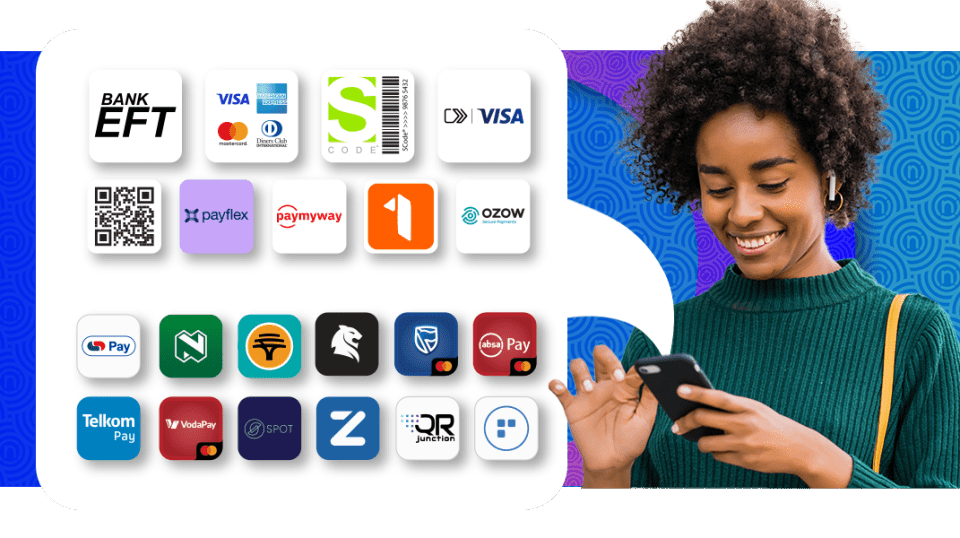
Black Friday 2025 in South Africa: Trends, Stats & Payment Tips
August 22, 2025
Top 5 Shopify alternatives in South Africa: In-depth comparisons
August 29, 2025Ready to simplify your eCommerce payments? That’s where PayShap’s Request-to-Pay payments come in. According to Statista, over 60% of all online payments in South Africa are through credit cards and bank transfers, with mobile wallets and other methods creeping behind.
Request-to-Pay (RTP) changes the game, allowing you to send a payment request to a customer. You can either use their bank account details or a proxy identifier such as a cellphone number, known as a ShapID, or a Shap Name to initiate a request. Once approved, payment will reflect immediately.
Whether you’re an online business owner or a freelancer looking to streamline receiving payments, PayShap’s RTP is the way to go. This guide breaks down all you need to know about this payment process, how to set it up, and a few use cases for research purposes.
Streamline eCommerce payments with Netcash.
PayShap RTP lets South African merchants send a payment request to a customer’s ShapID (mobile number) or account alias. The customer approves in their banking app; funds reflect instantly. Benefits: lower checkout friction, fewer failed payments/chargebacks, instant confirmation and better cash-flow. Enable RTP via a payments partner like Netcash and integrate it into your checkout.
What is PayShap’s request-to-pay, and how does it work?
As mentioned above, PayShap’s RTP is a secure, real‑time payment method that allows businesses and individuals to request a payment directly into their bank account.
Instead of using a bank card or account details, simply initiate an RTP by entering your customer’s ShapID or alias linked to their bank at checkout or through your banking portal.
Once the request is sent, the customer receives a secure notification, typically via their mobile banking app, displaying your name, requested amount, and any expiry date you set.
The customer can then choose to approve, decline, or, in some cases, partially pay the requested amount. Upon approval, the payment is settled instantly: funds are transferred in real time, and both you and your customer receive confirmation, often within seconds.
RTP in 3 steps
-
Merchant sends request (order total + reference) to customer’s ShapID/alias.
-
Customer approves the request in their banking app.
-
Funds settle instantly; both parties get confirmation.
Benefits of using PayShap’s request-to-pay
RTP brings a new level of convenience, speed, and security to the South African eCommerce space. For online retailers, it solves several long-standing issues around checkout friction, payment delays, and data breach risk, all while streamlining how you manage money coming in. It also saves time spent on administrative tasks such as sending reminder emails or invoices. Net result: higher conversion on mobile, faster fulfilment, fewer ‘proof of payment’ follow-ups, and less exposure to card data risk.
Here’s a breakdown of how each core benefit plays out in your day-to-day business operations.
Simplified checkout process
One of PayShap RTP's biggest advantages is its simplification of the customer’s checkout experience. Instead of asking your customer to type in card numbers, banking details, or go through a lengthy login process, you simply send a payment request using their mobile number.
This approach drastically reduces the number of steps required to complete a payment. For your customer, it’s as simple as:
- Choosing PayShap as the payment option at checkout.
- Entering their mobile number (or confirming their ShapID / Shap Name).
- Approving the request via their banking app.
No more struggling with one-time pins (OTPs), incorrect card details input, or bouncing between apps. This is particularly useful in mobile-dominant markets like South Africa, where a seamless mobile-first experience can differentiate between a completed sale and an abandoned cart.
From your side as the merchant, you’re initiating the request and guiding the payment flow, not waiting on customers. That leads to higher conversion rates and a better customer experience.
Real-time payment confirmation
Another game-changer is the instant nature of PayShap payments. Once a customer approves a payment request, funds are immediately transferred into your account, without waiting for clearance or batch processing. This translates into quicker order processing and fulfillment.
This instant confirmation has operational benefits such as reducing the need to chase down proof of payment or manually check for EFTs. It shortens the time from sale to shipment, particularly for stores selling physical goods, leading to faster delivery and happier customers.
In industries like fast fashion, grocery delivery, and even digital services, where speed is everything, this real-time confirmation gives your business a competitive edge. You know the money is in the bank account. No need to worry about reversals or delayed settlement.
Plus, customers also receive instant confirmation on their side, so they’re not left wondering whether their payment went through. This gives both you and your customers peace of mind.
Enhanced security and reduced fraud
RTP significantly reduces the risk of fraud and data breaches by removing sensitive information from the transaction process. Unlike card payments, where details can be stolen and reused, PayShap relies on ShapIDs (mobile numbers) or aliases securely linked to your bank account.
Several layers of protection are integrated into the system. These include no exchange of card numbers or CVVs, customers manually approving requests in their banking app, and bank authentication.
From a business perspective, this means fewer chargebacks and far less exposure to phishing, card skimming, or fake EFT proof of payment. For customers, there’s peace of mind knowing they’re authorising a real request in a secure environment.
ShapIDs are validated by their bank. This means there’s a much lower chance of errors or fraud-related support calls. That improves trust in your brand and reduces operational costs.
Improved cash flow management
In any business, especially eCommerce, cash flow is king. Waiting two to five days for funds to clear can stall growth, impact supplier payments, and force you to hold extra inventory.
The instant payment from RTP can completely change how you manage working capital in a few ways. You can restock in real time as soon as funds come in, pay your service providers or courier partners without delay, and avoid short-term credit or bridging finance to fulfil orders.
Cash flow is one of the biggest challenges faced by small and medium businesses in South Africa, so RTP can be transformative. You’re no longer operating in a holding pattern, waiting for funds to release. Instead, you can quickly reinvest into marketing, products, or fulfillment.
Even for larger retailers, the benefits are significant. Real-time inflows improve your ability to forecast revenue, manage supplier terms, and reduce reliance on expensive credit lines.

RTP use cases in eCommerce
RTP offers practical, real-world benefits for South African online retailers looking to simplify payments, reduce admin, and improve customer trust. Here’s how it can be used effectively.
1. Finalising payments after confirming stock availability
Instead of collecting payment upfront and risking stockouts or supply chain delays, you can verify stock first, then send a payment request. This reduces the need for manual refunds, prevents disappointment from overselling, and builds customer trust through transparency.
2. Handling pre-orders or backorders
For products launching soon or items awaiting shipment, RTP allows you to capture orders without charging upfront and request payment only when the item is ready. This ensures you don’t unnecessarily hold on to customer funds, giving you a clear picture of your bank balance.
3. Streamlining everyday transactions
RTP removes common checkout friction by letting you request payment via the customer’s mobile number (ShapID). This eliminates the need to capture card details or banking app logins manually. It speeds up checkout for mobile-first users, which most South Africans are.
PayShap’s RTP is beneficial for small businesses selling custom or made-to-order items, handling flash sales with limited inventory, and retailers who don’t use complex payment systems.
When to offer RTP at checkout
-
Mobile-heavy traffic: reduce typing and redirects on phones.
-
High EFT abandonment: replace manual PoP uploads with instant approval.
-
Stock-sensitive items: send RTP only when stock is confirmed.
-
COD replacement: secure confirmation before dispatch.
-
Large orders: avoid card limits/declines and chargebacks.
Adoption challenges and how to overcome them
Like any new payment system, integrating PayShap’s Request-to-Pay comes with its own set of challenges and growing pains. While the benefits are clear, businesses must plan for a smooth transition and customer education to unlock the full potential of this instant payment method.
Here are a few things to look out for and how to navigate through them.
1. Customer awareness and education
While over 90% of South African households have a mobile phone, many users aren’t familiar with PayShap and how RTP works. Unlike cards or EFTs, RTP requires a shift in behaviour. Customers have to wait for a payment prompt rather than initiating payment themselves.
How to overcome it:
- Add clear instructions at checkout and during communications
- Use tooltips, pop-ups, or short videos to explain the RTP flow
- Offer it as an optional payment method alongside familiar options
2. Integration complexity
Not all online payment solution platforms support PayShap natively, which means some businesses may need further developer support or third-party plugins to get started.
How to overcome it:
- Work with payment gateways or providers like Netcash that already support RTP
- Ask your bank about integration tools and available APIs
- Start with a limited rollout before scaling across your site
3. Resistance to change
Some customers and staff may be hesitant to adopt a new system, especially if they’ve grown accustomed to card-based payments.
How to overcome it:
- Highlight the benefits (security, speed, no card detail sharing)
- Offer incentives for early RTP users, like small discounts
- Train your support team to handle common PayShap RTP-related queries
4. Limited bank participation
While most major banks such as Absa, FNB, Standard Bank, and Capitec support PayShap, not all smaller institutions are on board yet. Personal and/or business banking services are enabled.
How to overcome it:
- Check which banks your ideal customer uses most
- Let customers know upfront if their bank doesn’t support RTP
Do you need flat, simple pricing that adjusts as your volumes grow?
Chat to us about your payment gateway needs.
Integration paths: making RTP work in your online store
PayShap’s Request-to-Pay (RTP) is easier to get up and running on your eCommerce platform when you follow a clear path. Here’s a step-by-step guide on how to get started:
-
Check platform compatibility
Begin by confirming whether your preferred eCommerce platform supports RTP directly or through a plugin. Popular platforms like WooCommerce and Shopify may offer third-party options or upcoming integrations with PayShap.
-
Choose a payment provider
Work with a payment solutions partner that already supports PayShap. This saves time on technical setup, offers 24/7 support, and ensures regulatory compliance is handled.
-
Register for RTP with your bank
Contact your business bank to enable RTP functionality and set up your ShapID (usually linked to your mobile number). Make sure your account is ready to receive real-time payments.
-
Integrate the API or plugin
Use your provider’s developer documentation or pre-built plugin to connect RTP to your checkout flow. Ensure the payment request process is triggered automatically after order confirmation.
-
Test the payment flow
Run internal tests to confirm payment prompts are sent, authorised, and confirmed in real time. This helps iron out any glitches before going live.
-
Train your team and go live
Ensure your staff understands how RTP works so they can assist customers confidently. Once you're ready, launch with clear messaging and optional RTP payment at checkout.

Comparing RTP with other South African payment options
RTP is a newcomer to the local payments scene, but how does it stack up against other widely used methods like card payments, EFTs, and Instant EFT services like Ozow or SnapScan?
Each option has its pros and cons depending on your business size, checkout flow, and customer base. Below is a quick comparison to help you understand where RTP fits in.
|
Feature/method |
PayShap RTP |
Card payments |
EFT / Instant EFT (Ozow, SnapScan) |
|
Speed |
Instant (real-time) |
Instant or delayed (depends on bank) |
Instant (with fees) |
|
Customer info needed |
Mobile number (ShapID) |
Card number, expiry date, CVV |
Bank login credentials or account number |
|
Ease of use |
High. No login or card needed |
Medium. Manual entry or saved cards |
Medium. Redirects to bank portals |
|
Security |
High. No sensitive data shared |
Moderate. Data shared at checkout |
Moderate. Data passes through a third party |
|
Refunds |
Manual via bank process |
Supported through a payment gateway |
Varies by provider |
|
Fees (to merchant) |
Low |
Medium to high |
Medium to high |
As PayShap adoption grows, its combination of security, speed, and simplicity may offer a compelling alternative. Making the switch, or adding RTP to payment options, is especially beneficial for mobile-centred eCommerce businesses aiming to reduce cart abandonment.
Final thoughts: seamless payments, stronger sales
PayShap’s RTP is more than just another payment option. It’s a smarter way to get paid instantly, securely, and with less friction at checkout. For South African eCommerce businesses, this could mean faster order processing, fewer abandoned carts, and improved cash flow.
Ready to modernise and streamline your customers’ payment journeys? Contact Netcash to explore how PayShap’s Request-To-Pay can work for your store and simplify your online sales.
Frequently Asked Questions
Need more information about the Netcash Payment Gateway?
Speak to a Payments Advisor today and see how we can help you with your online venture.

Candice Sergeant is a digital dynamo at Netcash, where she’s on a mission to help South African businesses level up their online game. As an eCommerce Product Owner, she’s got her finger on the pulse of the latest trends and technologies, constantly seeking out ways to boost sales and streamline operations. With a knack for spotting opportunities and a passion for innovation, Candice is your go-to guide for taking your e-commerce business to the next level.



